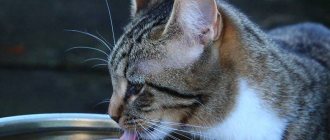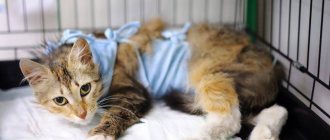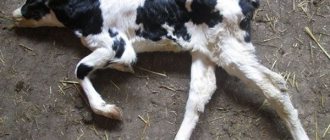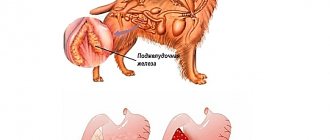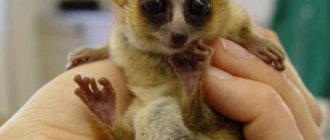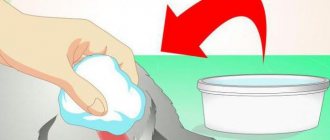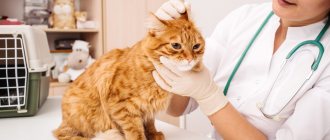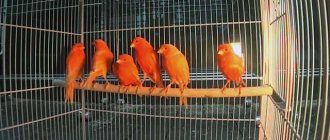What will you learn from the article?
- Acute pancreatitis
- Chronic pancreatitis
- Causes
- Symptoms of pancreatic inflammation
- Diagnostic methods
- Treatment of pancreatitis in cats
- Medical nutrition
- Prevention
Pancreatitis in cats is a dangerous and very common disease. The danger of the pathology is that the disease is difficult to identify immediately - pancreatitis has vague symptoms. And to make an accurate diagnosis, it is necessary to carry out a series of complex manipulations and tests. Therefore, every cat owner should know the causes, symptoms, methods of treatment and prevention of this pathology.
Pancreatitis is a malfunction (inflammation) of the pancreas, which is responsible for normal digestion. In healthy cats, pancreatic enzymes begin to break down fats from food only in the duodenum. In those who are sick, enzymes are activated in the gland, and it begins to “digest” itself. The toxins produced during this process poison other internal organs.
This gland is also responsible for the production of the hormone insulin, which is necessary to saturate cells with glucose. A malfunction in its operation leads to an uncontrolled release of sugar into the blood. Therefore, in advanced cases, pancreatitis in a cat can develop into a complex pathology - diabetes.
There are two forms of the disease: acute and chronic. These forms differ from each other in flow speed.
Chronic pancreatitis
This form of the disease is more dangerous and insidious. Pancreatitis slowly develops and “destroys” the cat’s body. Without any noticeable symptoms, the animal gets worse and worse. A chronic process can develop for years, and the owner of the animal will not know about it - this is its main danger.
The disease is indicated only by changes in the pet's behavior (the animal becomes lethargic and drowsy), incessant rumbling in the stomach, dulling of the fur and yellowish stools.
Diagnostics
Before treating pancreatitis in a cat, it is important to make sure of the diagnosis - the symptoms are similar to many other diseases. The condition of the pancreas is determined indirectly by the results of ultrasound, x-rays, and CT scans. In cats, this organ is poorly visualized; tomography with old equipment is a waste.
The only 100% way to find out the condition of an organ is diagnostic laparoscopy with collection of material for histology. Unfortunately, this is an expensive method that is not available everywhere and has a lot of contraindications (it is performed under general anesthesia). If it is nevertheless chosen, an intestinal and liver biopsy is performed simultaneously.
It is important to distinguish acute pancreatitis in cats from exacerbation of chronic pancreatitis. In the first case, this is a completely reversible state, a primary reaction. Chronicle – irreversible changes in tissues (atrophy, fibrosis, etc.). The pet’s chances of recovery drop sharply if, instead of treating the cause, the veterinarian simply stops the attack.
General and biochemical blood tests help confirm suspicions, exclude other diseases, and determine the condition of the body as a whole. Veterinarians often rely on lipase and amylase levels. But in cats with pancreatitis, unlike dogs and humans, these indicators do not play a significant role.
Causes
It is difficult to independently determine the cause of the disease. This will require in-depth medical research in a veterinary clinic. In complex cases, surgery may be required.
Main reasons:
- Pathologies in the structure of the organ and congenital developmental anomalies.
- Errors in power mode. You should not give cats fatty foods: lard, fatty meat and fish. It is unacceptable to feed food from the human table: canned food, sausages, smoked meats, spicy food. An attack of pancreatitis can be triggered by a sudden change in food.
- Intoxication of various etiologies.
- Hormonal diseases: various pathologies of the thyroid gland, diabetes mellitus, Cushing's syndrome, etc.
- Poisoning with household toxic substances: petroleum products, fertilizers, rat poison.
- Poisoning with medications: diuretics, hormonal, antibacterial. Common medications such as Furosemide and Aspirin can be dangerous for cats.
- Hypercalcemia.
- Obesity or severe malnutrition.
- Gastrointestinal diseases: gastritis, liver cirrhosis, cholecystitis, etc.
- Infection with helminths.
- Viral, fungal and bacterial infections.
- Trauma and mechanical damage to the abdominal cavity, unsuccessful surgical interventions (laparoscopy).
- Diabetes.
Some cat breeds are predisposed to the development of this pathology - these are animals of the eastern group: Siamese, Thai, Oriental, etc. The risk group includes animals after stress, pregnant individuals, and elderly pets (over 8 years old).
There are many reasons why pancreatitis occurs, so owners need to know its symptoms in order to promptly seek diagnosis and treatment from a veterinarian.
Causes of the disease
The main functions of the pancreas are the supply of digestive enzymes to the small intestine, which break down proteins, fats and carbohydrates entering the body. But at the same time, the gland also produces special substances - inhibitors of proteolytic enzymes, which protect the organ from self-digestion. Under certain conditions, the production of these substances can be disrupted, causing the activation of digestive enzymes stored in the cells of the pancreas, and they damage the organ, leading to the disease - pancreatitis.
The exact causes of pancreatitis in cats are not well understood. In most confirmed cases of the disease, the leading factor in the onset of the disease remains unknown. It is believed that in cats the development of pancreatitis can be provoked by such complex disorders of the body as:
- parasitic diseases (fascioliasis);
- secondary pancreatitis as a complication of bacterial infection;
- traumatic damage to an organ (for example, as a result of a fall from a height);
- obstruction of the pancreatic duct;
- various diseases accompanied by increased calcium levels in the blood (hypercalcemia);
- chronic kidney disease;
- immune-mediated disease;
- organophosphate poisoning;
- idiopathic causes;
- as well as some infectious diseases (toxoplasmosis, calicivirus, infectious peritonitis cause so-called viral pancreatitis in cats).
In most cases, the causes that trigger pancreatitis are not obvious. Pancreatitis rarely occurs as an independent disease; it is usually accompanied by inflammation of the small intestine and liver disease. This complex of diseases is known as “feline triaditis.”
Acute pancreatitis often becomes chronic, which, in turn, can lead to the development of a disease such as exocrine pancreatic insufficiency. With the development of purulent inflammation of the organ, the prognosis of the disease is poor.
There is no sex or age predisposition to feline pancreatitis. Even a kitten can have pancreatitis.
Symptoms of pancreatic inflammation
As we have already said, the pathology has vague symptoms - it is difficult to immediately make a correct diagnosis.
Typical symptoms:
- Profuse diarrhea is sudden, uncontrollable diarrhea.
- Dyspeptic symptoms - rapid saturation, heaviness in the stomach.
- Vomit. Most often it appears in advanced forms of the disease and during exacerbations.
- Cat feces have an unpleasant, sour smell. They contain particles of undigested food.
- Chronic constipation.
- Dehydration: dull, brittle coat, decreased muscle tone, dry skin and mucous membranes.
- Severe pain syndrome. The animal is worried, meows loudly, screams. Doesn't allow you to touch his stomach - he might bite.
- Hard belly.
- The animal hides in secluded places, avoids active games and communication with people, and becomes apathetic and lethargic.
- In the acute form of the disease, an elevated temperature appears.
- Jaundice color of mucous surfaces.
- A sharp decrease in appetite, exhaustion, anorexia.
- Lethargy.
- Respiratory failure: tachypnea (rapid breathing), shortness of breath.
Other symptoms of pancreatic inflammation are also possible. In the acute form of the pathology, the picture of the disease is clearly expressed. The chronic form is sluggish, the picture is blurry.
Forms of feline pancreatitis
In modern gastroenterology, depending on the degree of reversibility of changes, pancreatitis is distinguished between acute and chronic. In acute pancreatitis, provided the cause of the disease is eliminated, the inflammation of the organ and all the changes caused by it are completely reversible. In chronic pancreatitis, prolonged inflammation of the organ is observed, followed by the formation of irreversible changes. It is important to understand that making a diagnosis is very difficult and that the final diagnosis can only be established after performing an organ biopsy (taking a piece of the organ for analysis) followed by submitting the material for histology. Unfortunately, based only on history and clinical signs of the disease, it is impossible to distinguish acute pancreatitis from chronic pancreatitis.
Acute form
Acute pancreatitis usually develops rapidly and can be a consequence of organ injury, infection, or poisoning. It is very common for cats to develop traumatic organ damage after falling from a height.
It is worth noting that acute inflammation of the pancreas directly affects the functioning of the liver and intestines. Bacterial microflora from the affected organ enters the duodenum through the common bile duct, from where it then enters both the following parts of the intestine and the liver through the bile ducts. Thus, hepatopathy, hepatitis, and cholangitis may develop.
The prognosis for acute pancreatitis is cautious. There are high risks of developing various systemic complications - pulmonary edema, cardiac arrhythmia, peritonitis, diabetes mellitus, exocrine pancreatic insufficiency. In case of acute pancreatitis in a kitten, the prognosis is usually more favorable due to the high compensatory capabilities of the body.
Chronic form
Chronic pancreatitis is a long-term disease against the background of any irreversible physiological changes. Despite the fact that the initial cause of chronic pancreatitis in most cases cannot be determined, possible risk factors must be eliminated. Therefore, if you suspect chronic pancreatitis in a cat, you must:
- control the animal's diet;
- exclude the presence of possible hidden infectious diseases;
- monitor for the presence of hypercalcemia and treat its causes if detected;
- collect a complete medical history of the patient’s treatment and, if necessary, change treatment;
- Consider the use of immunosuppressive drugs if an autoimmune cause is suspected.
Diagnostic methods
Diagnosis of pancreatitis is possible only in a specialized clinic; the following methods are used for this:
- Ultrasound of the abdominal organs. Determines swelling of the gland, changes in the echogenic pattern of the affected organ, and inflammatory phenomena.
- Blood tests: clinical and biochemical. They show excess levels of liver enzymes, glucose and bilirubin levels, cholesterol, ALT, alkaline phosphatase. Biochemistry reveals hypocalcemia and hypokalemia. Clinical blood test – non-regenerative anemia.
- Rapid test for pancreatic lipase.
- Biopsy and histopathology are the most informative methods. They make it possible to distinguish the acute form from the chronic one, to detect fibrosis, edematous phenomena, parenchymal tissue necrosis, and ductal hyperplasia.
Please note: due to the difficulty of timely diagnosis, most animals cannot be definitively diagnosed until after necropsy. That’s why it’s so important to be attentive to your pets and show them to veterinarians at the first suspicious symptoms.
Description of the disease
Pancreatitis is a group of syndromes in which the pancreas becomes inflamed.
Typically, the enzymes needed to digest food begin working outside the organ. With pancreatitis, pancreatic juice is activated before it is released into the intestines. The organ begins to digest itself, releasing toxins into the blood. Digestive function suffers first of all - if a cat has pancreatitis, he does not receive enough nutrients even with a balanced diet. Diabetes mellitus often results from inflammation of the pancreas. Suppression of the gastrointestinal tract and general intoxication lead to dysfunction of internal organs.
In most cases, signs of pancreatitis in cats are subtle, unlike in dogs, which more often suffer from an acute form of the disease. In 70% we are talking about an idiopathic course - the spontaneous occurrence of the disease for no apparent reason. Relapses are recorded in half of cats with pancreatitis.
It is believed that Oriental breeds have an increased tendency to inflammation of the pancreas. Due to nonspecific signs, pancreatitis in cats is often diagnosed in late stages. Pancreatic necrosis, when gland enzymes destroy the heart, lungs and brain, is incurable in 90% of cases.
Treatment of pancreatitis in cats
Treatment in each individual case is prescribed individually after an accurate diagnosis has been established and concomitant diseases and symptoms have been identified.
The therapeutic strategy is selected taking into account the complexity of the course, stage, form and neglect of the pathological process. Self-medication is unacceptable!
- Starvation diet for 1-3 days to reduce the enzymatic functions of the diseased gland.
- Infusion therapy to combat dehydration. The drugs used are: 0.9% saline solution, Ringer's solution, Dextran-70.
- Antispasmodic and painkillers: Spazgan, No-shpa, Baralgin, Papaverine, etc.
- Antiemetics: Metoclopramide, Maropitant, Cerucal, Chlorpromazine.
- Heart remedies: Camphor, Cordiamine.
- Enzymes: Pancreatin.
- In acute pancreatitis, Gordox is prescribed to reduce the secretion of digestive enzymes.
- Animals with anorexia are fed through a nasoesophageal tube or PEG tube. Mirtazapine is used to stimulate appetite.
- In case of complications, a plasma transfusion or a complete blood transfusion is prescribed.
- A course of antibacterial therapy is indicated only to prevent septic phenomena.
- In the most severe cases, laparoscopy is performed to remove the necrotic part of the affected organ.
For the most effective treatment, it is important to identify the disease as early as possible.
Treatment
Only an experienced veterinarian who has previously repeatedly encountered this disease can establish an accurate diagnosis and prescribe adequate treatment for pancreatitis in an animal. If your pet does not require hospitalization, you will have to treat it yourself, scrupulously following the veterinarian's instructions, and periodically bring the animal for examination to evaluate its condition.
Treatment of pancreatitis in cats at home requires an integrated approach, including procedures such as diet, pain relief, taking antiemetic drugs, reducing the acidity of gastric juice and other measures to restore the health of the animal.
Restoring water-salt balance
In acute pancreatitis, animals' bodies rapidly lose fluid, which negatively affects the condition of all organs. Taking saline and medications intended for this purpose - such as Acesol, Trisol or Ringer - will help prevent dehydration and help restore the water-salt balance. If the animal is in a hospital, in addition to saline solution or special medications, it is given vitamins that support the functioning of the entire body.
Anesthesia
Excruciating pain greatly weakens your pet’s already compromised health. If an animal is suffering from acute pain, spinal anesthesia, which can only be done in a clinical setting, will help alleviate its condition. At home, medications prescribed by a veterinarian are used to reduce pain. In this case, it is very important to strictly follow the dosage and carefully monitor the well-being of the pet.
Reduced stomach acidity
Increased acidity of gastric juice, which occurs with a disease such as pancreatitis, often causes ulceration of the stomach and other parts of the digestive tract. In order to avoid such complications and prevent damage to the mucous membrane, it is necessary to bring the acidity of the stomach back to normal. Usually, for this purpose, drugs similar to “human” ones are used: Phosphalugel, Famotidine or Omeprazole.
Antiemetic therapy
One of the most severe symptoms of acute pancreatitis in animals is repeated painful vomiting. This is what causes life-threatening dehydration. One of the proven antiemetics, such as Cerucal, Zofran or Serenia (the latter option, according to veterinarians and cat owners, is the best), will help relieve your cat from extremely uncomfortable sensations. Antiemetics are given to animals once a day or (after consultation with a doctor) the daily dose is divided into two parts and fed every 12 hours.
Other drugs
If your pet has been diagnosed with pancreatitis, in addition to comprehensive treatment, he may need other medications.
So, if an animal has developed diabetes mellitus, drugs such as Lantus or Caninsulin are used to normalize glucose levels. Both of these products are distinguished by a high insulin content. They can be used exclusively as prescribed by a veterinarian, justified by the results of the tests performed. It is strictly prohibited to use them for preventive purposes! Uncontrolled use of insulin-containing drugs can cause irreparable harm to your pet's health!
Quick relief from the symptoms of pancreatitis is facilitated by taking a drug such as Pancreatin. Animals usually need 4 tablets of this product per day. However, if your pet suffers from allergies or the disease has caused any complications, the daily dosage can be reduced (only after agreement with the treating veterinarian).
Medical nutrition
After diagnosis and all therapeutic measures, sick cats are prescribed a therapeutic diet.
In the first days after therapeutic fasting, only liquid mucous porridges with water are allowed: Hercules, buckwheat, rice. Gradually, it is allowed to supplement the diet with steamed egg white omelettes, vegetable purees (zucchini, carrots) and low-fat lactic acid products (yogurt, kefir and cottage cheese). The food should be warm. Give it in small portions 5-6 times a day.
Industrial feed
Animals that are accustomed to dry food are prescribed medicinal food of the “super-premium” and “holistic” classes for life.
Read more about food for cats with gastrointestinal problems.
Their formulas consist of easily digestible ingredients and contain moderate amounts of fat and protein.
Medicinal foods for pancreatitis:
- Royal Canin Gastro Intestinal Moderate Calorie;
- Hill's i/d;
- Eukanuba Intestinal;
- Purina EN.
What is prohibited to feed:
- raw vegetables and fruits;
- smoked products;
- whole milk;
- fatty meats and fish;
- canned food, salty foods;
- sweets;
- bakery products;
- strong meat broths;
- fatty fermented milk products;
- cereal products;
- industrial feed of the "economy" class;
- dry food containing corn.
A therapeutic diet promotes a speedy recovery of the animal and prevents relapse.
Feeding cats with pancreatitis
So, your pet’s acute attack of pancreatitis was successfully relieved, and medications for further treatment were purchased. But the most important question is what and how to feed cats with pancreatitis? – still remains open.
First of all, switch the animal to small meals: feed it literally a teaspoon several times a day. Yes, this is very troublesome, but in this mode your pet is definitely not in danger of releasing a large amount of glucose into the blood, which means that the load on the still inflamed pancreas will be much less.
The food you feed your pet should be moderately warm (hot and cold are prohibited for pancreatitis).
Do not try to feed your animal several types of food at one time. If your pet prefers to just lap up the broth today, don't discourage it. Tomorrow you can offer him some pureed steamed meat with rice or chicken minced in a meat grinder, but be sure to do one thing.
Provide the animal with free access to fresh, clean water. Change the water in the drinking bowl daily. The usual one from the tap will not work for pancreatitis. It is better to give your cat bottled or filtered water.
Prevention
- Follow the vaccination schedule, regularly deworm and do not neglect preventive examinations.
- Strictly adhere to the diet, monitor the quality of food and ready-made commercial feed, and stop attempts at home to “treat” your pet with food from the table.
- Monitor your pet's weight and prevent obesity.
- Strictly adhere to the recommendations of veterinary specialists during treatment of chronic pancreatitis in the acute phase and during remission. Do not replace medications or change dosages of medications.
- Get rid of all poisonous houseplants.
- Place household chemicals out of the reach of cats.
Strict adherence to these simple rules will help your pet stay healthy longer.
Videos of veterinarians
Symptoms
Acute pancreatitis begins suddenly and is manifested by the following symptoms:
- indomitable, repeated vomiting, including on an empty stomach;
- severe pain, even shock;
- the abdomen is sharply painful on palpation;
- dehydration (sunken eyes, skin folds do not straighten, pale mucous membranes);
- lethargy, stupor;
- lack of stool or diarrhea;
- yellowness of the mucous membranes in case of obstruction of the outflow of bile.
In a chronic course, the picture becomes blurred:
- Vomiting is periodic.
- Digestion of food is impaired.
- The fur becomes dull.
- The stool is irregular, often watery.
- Appetite decreases.
